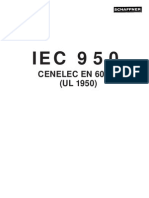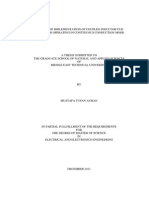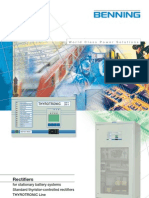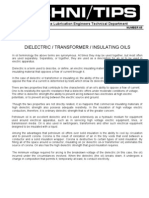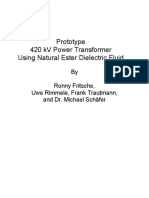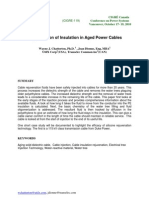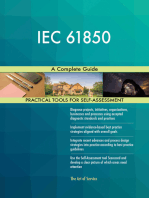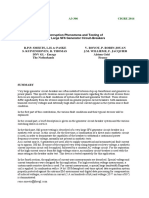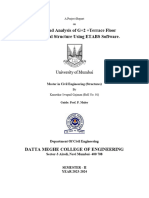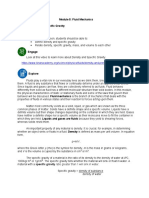Impact of Rain On Insulation Performance
Impact of Rain On Insulation Performance
Uploaded by
des1982Copyright:
Available Formats
Impact of Rain On Insulation Performance
Impact of Rain On Insulation Performance
Uploaded by
des1982Original Title
Copyright
Available Formats
Share this document
Did you find this document useful?
Is this content inappropriate?
Copyright:
Available Formats
Impact of Rain On Insulation Performance
Impact of Rain On Insulation Performance
Uploaded by
des1982Copyright:
Available Formats
WG D1.
45
technical brochure 634
Impact of rain on insulator performance
Laboratory and field experience toward guidelines
for the selection of insulators under rain condition,
including heavy rain
Members
A. Pigini, Convenor (IT), D. de Mello, Secretary (BR), R. Houlgate (GB), Z. Jun (CN),
K. Kondo (JP), B. Kruska (DE), R. Matsuoka (JP), F. Perrot (GB), G. Pirovano (IT),
V. Sklenicka (CZ), J. Seifert (DE), R. Wesley (BR),
D. Wu (SE), M. Yamarkin (RU)
Introduction station insulators, with many flashovers occurring on apparatus
equipped with porcelain housing (Table 1). Rain related events
There is the concern, supported by some field experience, have been largely mitigated by the adoption of polymeric
that the standardized wet test methods may not be sufficient housings.
to cater for heavy rain conditions. Of particular concern is the
question if the presently-used test parameters and methods
for rain tests are adequate to address all types of environment,
with emphasis on the rate of precipitation, uniformity of the
precipitation especially at UHV and the resistivity of the
water used. Consequently, several organizations have either
devised non-standard wetting tests, or investigated the effect
of combined pollution and rain conditions, to either qualify
proposed insulation solutions or to investigate their performance
or to study the behaviour under these conditions.
The WG tried to give a reply to the above concerns, on the
basis of the state of the art and of new ad hoc tests performed.
Table 1- DC station insulators with porcelain housing. Flashover percentage
In-service insulator flashover under as a function of the wetting condition
atmospheric conditions
Rain characteristics under natural
The relevance of heavy rain in relation to insulation flashovers environment
was first observed from field experience. Special attention is given
in the brochure to long and large station insulators in vertical The more relevant rain parameters, as far as insulator
position, being the most critical case under rain conditions. The performance is concerned, are rain intensity in mm/minute and
particular case of wall bushings is also outlined in the Annex. rain conductivity in S/cm. Thereafter, an analysis of the main
Service experience from AC systems indicates that rain is not parameters found in nature is made in relation to the different
a particularly severe environmental stress for line insulators, parts of the world. The data analysis has confirmed that generally, a
whilst a higher severity has been reported for station insulators, rain intensity of 1.5mm/minute conservatively represents normal
with few rain-related flashovers observed for long station natural rain intensity. However in some areas, such as tropical
insulators in vertical position, with small distance between and semitropical areas, whilst a rain intensity of 1.5mm/minutes
sheds. Rain resulted in a much more severe condition for DC may still represent natural rain of high intensity with very high
No. 283 - December 2015 ELECTRA 63
WG D1.45
technical brochure 634
Fig.1 Tropical or semi-tropical environment: maximum intensity of the precipitation for different
return periods
repetition rates, rain intensities of 5mm/minute to 10mm/minute probability of heavy rain phenomena is not uncommon. The
are not uncommon for relatively short duration phenomena (see same applies for rain conductivity: due to the short duration
Fig. 1). As far as the conductivity of rain is concerned, generally of rain phenomena with high conductivity values, high
a conductivity of 100S/cm covers conservatively the observed conductivity rain can be neglected from the point of view
values in nature. However for short period of time much higher of insulator overvoltage performance, while it may have to
conductivities (up to 1000S/cm) can occur in special areas be taken into account with reference to the possible impact
characterized by high pollution (see Table 2). under permanent applied voltage, either AC or DC, in special
areas where the probability to have high conductivity rain is
The impact of high rain intensities on the electrical power not uncommon.
system performance was analyzed taking into account the
different electrical stresses involved. Simulation of artificial rain in
When the impact of rain under over-voltages conditions is laboratory
considered the probability of occurrence of high over-voltages
and high rain intensities phenomena is to be taken into As far as the simulation of natural rain in the laboratory is
account. Thus only phenomena with relatively high repetition concerned, at present only tests under standard rain conditions
rates are to be considered and the standard rain intensity of (rain intensity rate 1.5mm/minute, water conductivity 100S/
1.5mm/minute can still be deemed as adequate to represent cm) are covered under the present edition of IEC60060, while
the actual rain condition in most circumstances. High rain higher intensities were mentioned in the previous edition, even
intensity values are on the contrary to be taken into account if limited to AC tests. Non-standard rain conditions have been
with reference to the possible impact under permanent used in the laboratory for special research and type tests and are
applied voltage, either AC or DC, in special areas where the nowadays considered in some National Standards.
Table 2. Extreme water conductivity values recorded in Japan in the period 1993-1997
No. 283 - December 2015 ELECTRA 65
WG D1.45
technical brochure 634
Influence of artificial rain on the AC: AC tests under standardized rain conditions are nowadays
insulators performance foreseen only for equipment and apparatus with voltage ratings
equal or lower than 245 kV. The purpose of the very high values
The influence of standard and non-standard rain condition selected is to also verify the performance under switching
on the insulator performance was then analyzed, based on a overvoltages, foreseen only for system voltages higher than 245 kV.
review of historical test results, supplemented by specific tests
made within the frame of this present WG. When considering the need to perform AC tests for higher
system voltages, already covered by SI tests, it has to be considered
As far as Switching Impulse (SI) tests are concerned, a that, as for SI, the probability to have very severe rain conditions
limited influence of the rain intensity and conductivity was at the same time of very high temporary overvoltages is very
found. low. Thus the performance under severe rain conditions, when
applicable, is to be verified only at service voltage level.
The situation is rather different as far as the performance
under AC and DC permanent voltage is concerned. New tests For insulators to be applied in contaminated environment
performed confirmed that rain intensity and conductivity pollution tests with clean fog are generally more severe than tests
may significantly influence the insulator performance under with heavy rain. Thus standard clean fog pollution tests and SI
clean condition, as shown in the examples of Fig. 2. tests can be generally sufficient to verify the design. The situation
is more complicated for insulators to be applied in rather
For contaminated insulators standardized pollution tests clean environments. Tests under clean conditions (negligible
with clean fog was generally found more severe than tests contamination) have indicated that insulators with profiles
with humidification by rain, irrespectively from the rain rate complying with IECTS60815 and having passed standard SI
and conductivity. wet tests, will generally be able to withstand service voltages
under rain intensities up to a few mm/minute with a maximum
Artificial rain tests necessary for rain conductivity of 500S/cm. Only assuming very extreme
conditions (rain rate of 10 mm/minute and water conductivity
design verification of 1000S/cm), heavy rain tests may need to be recommended
to verify the insulator design.
SI: Taking into account the limited dependence of the
flashover voltage on rain conductivity and intensity and the It has however, to be taken into account that the performance
low probability of a very high overvoltage value combined reduction due to heavy rain is more pronounced for small
with very severe rain conditions, it may be concluded that the distances between sheds. In any case, improvement of the
present standard SI tests are adequate to verify the design of strength can be obtained by the adoption of water cut sheds or
external insulation under Switching overvoltage. booster sheds.
Fig. 2 AC one minute wet tests on clean insulators.
No. 283 - December 2015 ELECTRA 67
WG D1.45
technical brochure 634
DC: As for AC systems, for DC systems, the performance under may reach much higher values in specific situations.
heavy rain, if necessary to represent specific environmental Due to the low probability that highest overvoltage values
constraints, is to be verified only at service voltage level and occur at the same instantaneous time of the most severe rain
heavy rain tests may be necessary only to represent very extreme conditions, the standardized rain rate may be considered
rain conditions. as adequate for Switching Impulse Voltage (SI) tests for all
environments.
As for AC strength reduction due to heavy rain is more The present Standardized rain tests, for insulators complying
pronounced for small distances between sheds. Distances with pollution requirements as specified in IECTS60815,
between sheds higher than the ones used with AC voltage are are adequate to verify the insulator design of insulators to be
generally required for heavy rain environments. applied in normal environmental conditions, with limited
probability of having severe instantaneous rain conditions.
Artificial rain tests at UHV Only the tolerances on the rain parameters foreseen in the
present standards may need to be adjusted to facilitate the
Practical experience confirms the difficulty to perform the tests on UHV insulators.
standard SI tests on UHV apparatus and fully respecting the Only for very extreme environments characterized by very
standard requirements, as reflected by a questionnaire circulated high rain rate and/or very high rain conductivity and when
amongst a number of key laboratories. there is the concern that the profile is not adequate (e.g. too
small distance between sheds) heavy rain tests to verify the
It has to be considered that SI test results usually contain a performance under permanent voltage, simulating severe
large scatter, due to the influence of the many parameters rain conditions, may be necessary.
involved. Additionally, the influence of variation of both rain As a proposal an annex could be added to the present
intensity and resistivity is relatively low with SI and in general relevant standards indicating the minimal requirements for
within the standard deviation, typical for this kind of tests. tests with higher rain intensities and lower rain resistivities
Thus a possible solution for UHV tests would be to increase than in the present standards, indicating that the values
the required tolerances. Based on the outcome of the above could be used by agreement between the purchaser and the
mentioned questionnaire, the increase of the tolerances on manufacturer to represent heavy rain conditions.
the precipitation rate from 1 mm/minuteto3mm/minute for Large distances between sheds are advisable for environments
both the average and individual measurements was proposed, with severe rain conditions.
assuming that this condition could be reached more easily by the
laboratories involved.
As far as heavy rain tests under AC and DC voltages are
concerned, there are no specific problems in the UHV range if
the tests are to be carried out at service voltages (or close to it).
Performance of DC wall bushing
under rain conditions
BROCHURE N 634
The aspect of DC through-wall bushing was analyzed and is
presented in the Annex. It is shown that the performance is very (en anglais seulement)
particular, due to the interaction of the outer and inner active
parts of the bushing. In this case the rain characteristics (intensity (in English only)
or conductivity) are not very important, as the performance is
related to the rain uniformity in relation to the resistivity of the
Disponible sur / Available on:
dry part of the bushing surface and to the characteristics of the
inner active part. It is also shown that the problems associated
with through-wall bushing performance were very much www.e-cigre.org
attenuated by the introduction of polymeric housings.
Prix non-Membres / Non-Member Price:
Conclusions
135 e
Service experience indicates that the performance of
insulators under rain may be critical especially for large
Purchase (non-members)
station insulators in vertical positions.
While average rain conditions are well represented by the Free download (members)
standardized rain parameters, instantaneous rain parameters
No. 283 - December 2015 ELECTRA 69
You might also like
- A 3D FDTD Code Implemented in MATLABDocument38 pagesA 3D FDTD Code Implemented in MATLABAli Mhd100% (2)
- Mccune Sandra Clark William Mcgrawhills 500 Precalculus QuesDocument174 pagesMccune Sandra Clark William Mcgrawhills 500 Precalculus QuesGwynbleidd WitcherNo ratings yet
- The Technology of Instrument Transformers: Current and Voltage Measurement and Insulation SystemsFrom EverandThe Technology of Instrument Transformers: Current and Voltage Measurement and Insulation SystemsNo ratings yet
- 2011-LER-RC-Transformer Failure Due To Circuit-Breaker-Induced Switching TransientsDocument12 pages2011-LER-RC-Transformer Failure Due To Circuit-Breaker-Induced Switching Transientsjulio_nunes21No ratings yet
- High Voltage InsulatorsDocument13 pagesHigh Voltage InsulatorsDebojyotiMukherjeeNo ratings yet
- Breakdown in Solid Dielectrics: S.Sundara Mahalingam AP/EEE, MSEC SivakasiDocument36 pagesBreakdown in Solid Dielectrics: S.Sundara Mahalingam AP/EEE, MSEC SivakasiGooge ReviewerNo ratings yet
- Surge Arrester ComsolDocument9 pagesSurge Arrester ComsolJefferson Costa100% (1)
- Compact Power Transformers For Substation in Urban Areas Using Hybrid Insulation SystemDocument8 pagesCompact Power Transformers For Substation in Urban Areas Using Hybrid Insulation SystemR0B0T2013No ratings yet
- 7.21 Outdoor Bus StructuresDocument191 pages7.21 Outdoor Bus StructuresEdyta MarzecNo ratings yet
- The Corona Effect On High Voltage Transmission LinesDocument4 pagesThe Corona Effect On High Voltage Transmission LinesOttoNo ratings yet
- Design & Testing of ZnO Lightening ArresterDocument19 pagesDesign & Testing of ZnO Lightening ArrestersureshnfclNo ratings yet
- Operating Instruction of Surge ArresterDocument16 pagesOperating Instruction of Surge Arresterprathaban723No ratings yet
- Application Note IEC 950 e 4Document10 pagesApplication Note IEC 950 e 4crocsvNo ratings yet
- VCB Switching Furnace LoadDocument8 pagesVCB Switching Furnace LoadkrcdewanewNo ratings yet
- Distribution of Power System: ELEC 423Document34 pagesDistribution of Power System: ELEC 423Saleh AhmadNo ratings yet
- GES Floating Wye Metal Enclosed Capacitor Banks Fusing ConcernsDocument12 pagesGES Floating Wye Metal Enclosed Capacitor Banks Fusing ConcernsbansalrNo ratings yet
- 20 1368 NPDocument20 pages20 1368 NPsilicomNo ratings yet
- Design and Implementation of Coupled Inductor Cuk Converter Operating in Continuous Conduction ModeDocument280 pagesDesign and Implementation of Coupled Inductor Cuk Converter Operating in Continuous Conduction ModeAhmed AsnagNo ratings yet
- Thyrotronic GBDocument8 pagesThyrotronic GBjunpamsNo ratings yet
- Newzeland Power Transformers Loading GuideDocument10 pagesNewzeland Power Transformers Loading GuidekrcdewanewNo ratings yet
- 1 Beckwith Electric Upgrading Generator ProtectionDocument10 pages1 Beckwith Electric Upgrading Generator Protectionمحمد الأمين سنوساويNo ratings yet
- Iec 60099-4 - 2009Document30 pagesIec 60099-4 - 2009Wellington MendonçaNo ratings yet
- Catalog Composite+Insulator-CNME PDFDocument31 pagesCatalog Composite+Insulator-CNME PDFAneelNo ratings yet
- 1502957542lectrure 9 10 KUETDocument26 pages1502957542lectrure 9 10 KUETAnikaNo ratings yet
- Dielectric, Transformer, Insulating OilsDocument2 pagesDielectric, Transformer, Insulating OilsJason BrendonNo ratings yet
- Surge Arrester TypeDocument4 pagesSurge Arrester Typefahri adrianNo ratings yet
- Special Session - Neeraj Goyal - Co-Chairman - TRAFOTECH 2018Document25 pagesSpecial Session - Neeraj Goyal - Co-Chairman - TRAFOTECH 2018Muhammad Qumar NazeerNo ratings yet
- Ak Carlite Lite 042413Document46 pagesAk Carlite Lite 042413ecaph244No ratings yet
- 01 Effects of Very Fast Transient OvervoltagesDocument6 pages01 Effects of Very Fast Transient Overvoltagespreddyrk100% (1)
- SuperS InhibitedTransformerOil SpecDocument2 pagesSuperS InhibitedTransformerOil Spechhahn01No ratings yet
- Water TreeingDocument10 pagesWater TreeingIoannis ChristodoulouNo ratings yet
- ElectricMagneticCalculationsWithFEM 2 PDFDocument121 pagesElectricMagneticCalculationsWithFEM 2 PDFnasiruddinNo ratings yet
- Ds Ac DC HV Test Set PGK 110 HB Baur En-GbDocument3 pagesDs Ac DC HV Test Set PGK 110 HB Baur En-GbRomany AllamNo ratings yet
- Cigré2016 Experiencesandinnovationsinpowertransformershort Circuitcurrentwithstandtesting A2 304Document11 pagesCigré2016 Experiencesandinnovationsinpowertransformershort Circuitcurrentwithstandtesting A2 304cisnatelNo ratings yet
- ABB UniPack Datasheet TERRA 1600kVA WEBDocument2 pagesABB UniPack Datasheet TERRA 1600kVA WEBprashanth chandrashekarNo ratings yet
- High Voltage Insulators PDFDocument8 pagesHigh Voltage Insulators PDFKhaled IbrahimNo ratings yet
- Touch and Step Potentials, Limits and ApplicationDocument17 pagesTouch and Step Potentials, Limits and ApplicationAnoop PrajapatiNo ratings yet
- PHD Thesis 13.11.2018 P. CicheckiDocument225 pagesPHD Thesis 13.11.2018 P. CicheckiCésar Díaz LiberonaNo ratings yet
- Modelling and Simulation of Hybrid Micro Grid Employing DG, PV, Wind and Fuel CellDocument7 pagesModelling and Simulation of Hybrid Micro Grid Employing DG, PV, Wind and Fuel Cellرافع العرفيNo ratings yet
- TC Abb Tpu 2012Document98 pagesTC Abb Tpu 2012macNo ratings yet
- EDS-50-05 132-400 KV AC Stations - Standard Reactor SizesDocument5 pagesEDS-50-05 132-400 KV AC Stations - Standard Reactor Sizesraghavendran raghuNo ratings yet
- Internal Arc Test PDFDocument5 pagesInternal Arc Test PDFsaravanaplusNo ratings yet
- Siemens Transformers Prototype 420kv Power Transformer PDFDocument18 pagesSiemens Transformers Prototype 420kv Power Transformer PDFbergo197676No ratings yet
- MVLV Wire and CableDocument66 pagesMVLV Wire and CableMahmoud FawzyNo ratings yet
- PDS Midel 7131Document4 pagesPDS Midel 7131RoboTriggerNo ratings yet
- Comp Insulator PDFDocument10 pagesComp Insulator PDFryan_jay55No ratings yet
- SSD Fresh Water GeneratorsDocument2 pagesSSD Fresh Water GeneratorsVitmannNo ratings yet
- Dielectric Coatings For High Voltage Gas Insulated Switchgear - Dennis Van Der Born PDFDocument306 pagesDielectric Coatings For High Voltage Gas Insulated Switchgear - Dennis Van Der Born PDFAmila FritzgeraldNo ratings yet
- ABB Low Voltage Surge Arrester PDFDocument8 pagesABB Low Voltage Surge Arrester PDFrajpre1213No ratings yet
- ETS-50-06-12-E1 High-Voltage Components - Surge Arrester, Metal Oxide 170 KV PDFDocument5 pagesETS-50-06-12-E1 High-Voltage Components - Surge Arrester, Metal Oxide 170 KV PDFraghavendran raghuNo ratings yet
- 4 Main Types of Insulator Used in Overhead LinesDocument9 pages4 Main Types of Insulator Used in Overhead LinesArvind GangwarNo ratings yet
- Transformer Logistics Monitoring Key To Customer SatisfactionDocument6 pagesTransformer Logistics Monitoring Key To Customer SatisfactionMasplantiz Technologies Private Ltd.No ratings yet
- Acsr Din en 50182Document1 pageAcsr Din en 50182MarioNo ratings yet
- Cable Layout and System Design (High Voltage XLPE Cable Systems Techincal User Guide) 13-09-17Document6 pagesCable Layout and System Design (High Voltage XLPE Cable Systems Techincal User Guide) 13-09-17anamulk-1No ratings yet
- E63021 - Dry-Type Air Core Shunt Reactor SpecificationsDocument1 pageE63021 - Dry-Type Air Core Shunt Reactor SpecificationsRichard PolNo ratings yet
- CIGRE-119 Rejuvenation of Insuslation in Aged Power CablesDocument11 pagesCIGRE-119 Rejuvenation of Insuslation in Aged Power CableskamuikNo ratings yet
- Arc Control in Circuit Breakers: Low Contact Velocity 2nd EditionFrom EverandArc Control in Circuit Breakers: Low Contact Velocity 2nd EditionNo ratings yet
- VSC-FACTS-HVDC: Analysis, Modelling and Simulation in Power GridsFrom EverandVSC-FACTS-HVDC: Analysis, Modelling and Simulation in Power GridsNo ratings yet
- Application of Flexible AC Transmission System Devices in Wind Energy Conversion SystemsFrom EverandApplication of Flexible AC Transmission System Devices in Wind Energy Conversion SystemsNo ratings yet
- Improved Electrical Safety Through High Resistance GroundingDocument6 pagesImproved Electrical Safety Through High Resistance Groundingdes1982No ratings yet
- A View On Internal Arc Testing of LV SwitchgearDocument8 pagesA View On Internal Arc Testing of LV Switchgeardes1982No ratings yet
- Transformer Failure Due To Circuit Breaker Induced SwitchingsDocument13 pagesTransformer Failure Due To Circuit Breaker Induced Switchingsdes1982No ratings yet
- Condition-Based MaintenanceDocument4 pagesCondition-Based Maintenancedes1982No ratings yet
- Managing The Risk of Protection Relay Failure: Project Specification Consultation ReportDocument42 pagesManaging The Risk of Protection Relay Failure: Project Specification Consultation Reportdes1982No ratings yet
- CIRED 2011 - 0875 - FinalDocument4 pagesCIRED 2011 - 0875 - Finaldes1982No ratings yet
- 2015 Jicable - Risk On Failure Based On PD Measurements in Actual MV PILC and XLPE Cables.Document3 pages2015 Jicable - Risk On Failure Based On PD Measurements in Actual MV PILC and XLPE Cables.des1982No ratings yet
- The Full Underground Distribution Transformer in Practice: Cired Cired Cired CiredDocument4 pagesThe Full Underground Distribution Transformer in Practice: Cired Cired Cired Cireddes1982No ratings yet
- 2016 Cepsi - On-Line Fault Detection and Localization in Medium Voltage NetworkDocument6 pages2016 Cepsi - On-Line Fault Detection and Localization in Medium Voltage Networkdes1982No ratings yet
- Jicable2015 LiraDocument6 pagesJicable2015 Lirades1982No ratings yet
- 2014 CEPSI - On-Line PD and Fault Location With SCGDocument8 pages2014 CEPSI - On-Line PD and Fault Location With SCGdes1982No ratings yet
- Reliability Measures: Failure and Root Cause Analysis (FRCA) For GIS Early FailureDocument5 pagesReliability Measures: Failure and Root Cause Analysis (FRCA) For GIS Early Failuredes1982No ratings yet
- HV Underground Oct 2017Document6 pagesHV Underground Oct 2017des1982No ratings yet
- CableSystemHV CT EN PDFDocument112 pagesCableSystemHV CT EN PDFdes1982No ratings yet
- CIGRE 2008 A3-207 Int Arc PDFDocument10 pagesCIGRE 2008 A3-207 Int Arc PDFdes1982No ratings yet
- CIGRE 2008 A3-207 Int ArcDocument10 pagesCIGRE 2008 A3-207 Int Arcdes1982No ratings yet
- Cigre 2016 - B1-205Document9 pagesCigre 2016 - B1-205des1982No ratings yet
- CIRED2007 0383 PaperDocument4 pagesCIRED2007 0383 Paperdes1982No ratings yet
- Cross-Bonding Cable and Box Model Based On Pulse Reflection MeasurementDocument8 pagesCross-Bonding Cable and Box Model Based On Pulse Reflection Measurementdes1982No ratings yet
- Low-Current Behaviour and Current Chopping of Vacuum Arcs: Smeets, R.P.PDocument150 pagesLow-Current Behaviour and Current Chopping of Vacuum Arcs: Smeets, R.P.Pdes1982No ratings yet
- Interruption Phenomena and Testing of Very Large SF6 Generator Circuit-BreakersDocument11 pagesInterruption Phenomena and Testing of Very Large SF6 Generator Circuit-Breakersdes1982No ratings yet
- Rene Smeets: Inductive Load Switching Standardization StatusDocument48 pagesRene Smeets: Inductive Load Switching Standardization Statusdes1982No ratings yet
- Rubber ProductionDocument1 pageRubber ProductionfebiantiNo ratings yet
- The Georgian Technical University The Department of Electrical Engineering and Electronics Simon NemsadzeDocument231 pagesThe Georgian Technical University The Department of Electrical Engineering and Electronics Simon Nemsadzepeter vanderNo ratings yet
- Activity 1 Pxy, Txy DiagramsDocument3 pagesActivity 1 Pxy, Txy DiagramsPatricia ManaogNo ratings yet
- Mechyr1 Chapter 8::: Introduction To MechanicsDocument22 pagesMechyr1 Chapter 8::: Introduction To MechanicsAgrata PouloseNo ratings yet
- 7 GHHGDocument9 pages7 GHHGVicente SazilNo ratings yet
- GE Design GuideDocument53 pagesGE Design GuideGuido Kats100% (1)
- Curriculum Map TemplateDocument4 pagesCurriculum Map TemplateVon bhrianeNo ratings yet
- Advantage EP 950A ASTM E119 Wall Burn - Intertek TestDocument14 pagesAdvantage EP 950A ASTM E119 Wall Burn - Intertek TestJulio NeumannNo ratings yet
- Constant Terminal Rate Solution: Ei-Funcrion Solution: Prepared By: Lulav Saeed Supervisor: MR - All'a RasulDocument12 pagesConstant Terminal Rate Solution: Ei-Funcrion Solution: Prepared By: Lulav Saeed Supervisor: MR - All'a RasulLulav BarwaryNo ratings yet
- Reaction TurbineDocument18 pagesReaction TurbineWhatsApp Back up 1No ratings yet
- HW02 - Ly Thierno Mouhamadou Samassa - D2021738Document4 pagesHW02 - Ly Thierno Mouhamadou Samassa - D2021738Thierno Samassa LyNo ratings yet
- Tray Dryer - Lab ReportDocument9 pagesTray Dryer - Lab Reportinurhadi1350% (2)
- Bertat DiagramDocument2 pagesBertat Diagramsamgonz04.2002No ratings yet
- Laws - of Thermodynamics - NotesDocument1 pageLaws - of Thermodynamics - NotesAnudeep Reddy SolletiNo ratings yet
- MEE403-Heat Transfer-Ch03Document44 pagesMEE403-Heat Transfer-Ch03ZAVEN TORTIANNo ratings yet
- Installation of A Rollix Slewing Ring - enDocument14 pagesInstallation of A Rollix Slewing Ring - enAna MarNo ratings yet
- 005 012 EquationDocument8 pages005 012 Equationchemical_alltimeNo ratings yet
- Qingdao Yamabase Engine Parts CoDocument7 pagesQingdao Yamabase Engine Parts CoVictor PerezNo ratings yet
- Radiography Testing - NDT Inspection - TWIDocument5 pagesRadiography Testing - NDT Inspection - TWIKolusu SivakumarNo ratings yet
- Concrete Technology Lab Manual - UCVC 0605Document58 pagesConcrete Technology Lab Manual - UCVC 0605PrinceNo ratings yet
- Material Property Charts Lecture Unit 2 Pptchaen23Document22 pagesMaterial Property Charts Lecture Unit 2 Pptchaen23pranavNo ratings yet
- Design Basis Report - G+2+terrace Floor - Sangolda Project at GoaDocument29 pagesDesign Basis Report - G+2+terrace Floor - Sangolda Project at GoaSwapnil KNo ratings yet
- Ferromagnetism Alla IsingDocument34 pagesFerromagnetism Alla IsingKoustav MukherjeeNo ratings yet
- Columns: Md. Faisal Rahman Badal Lecturer Dept. of Mechatronics Engineering, RUETDocument25 pagesColumns: Md. Faisal Rahman Badal Lecturer Dept. of Mechatronics Engineering, RUETNaimur Asif BornoNo ratings yet
- SPD 20 ADocument70 pagesSPD 20 Ayukoh900No ratings yet
- Diamond Head Base CollapsingDocument18 pagesDiamond Head Base Collapsingsqueaker12No ratings yet
- ChapE SHALYFORMATIONSDocument8 pagesChapE SHALYFORMATIONSdiego isaacNo ratings yet
- Module 5 Fluid MechanicsDocument12 pagesModule 5 Fluid MechanicsJai FloresNo ratings yet












